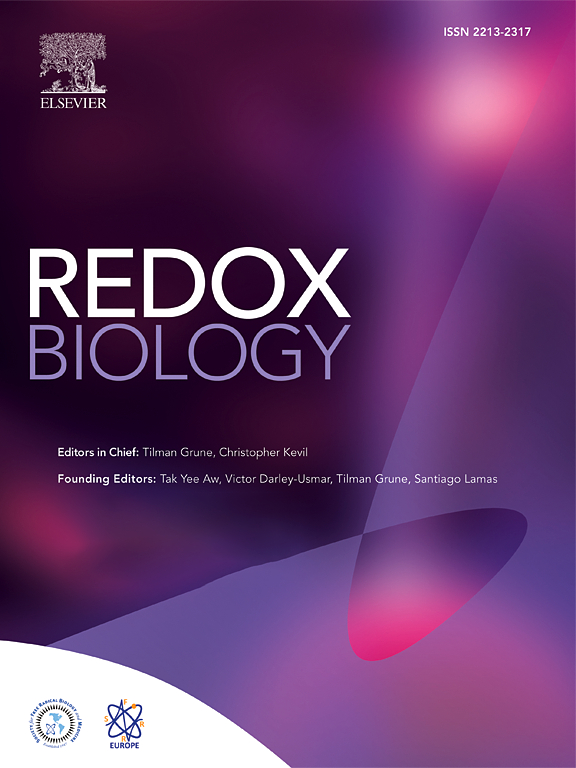USP10通过稳定细胞质Mfn2来防止压力过载诱导的线粒体形态功能缺陷和病理性心肌肥大
IF 11.9
1区 生物学
Q1 BIOCHEMISTRY & MOLECULAR BIOLOGY
引用次数: 0
摘要
越来越多的证据表明,线粒体形态功能缺陷在病理性心肌肥大和心力衰竭中起着重要作用。去泛素化酶(deubiquitination enzyme, DUBs)参与蛋白质稳定性的维持并调节多种细胞过程,但DUBs是否参与线粒体形态功能的维持仍不清楚。本研究旨在探讨压力超载引起的病理性心肌肥厚中DUBs与线粒体形态功能异常之间的可能联系,并探讨其潜在的分子机制。RNA测序结果显示,在压力超载诱导的肥大和衰竭心肌中,泛素介导的蛋白水解显著富集,USP10被鉴定为其中下调最显著的基因,并与人类心脏样本中心力衰竭的严重程度相关。在体外和体内,USP10的恢复可以减轻心脏肥大和功能障碍以及线粒体形态功能异常。免疫沉淀和质谱分析表明,USP10直接与线粒体外膜蛋白Mfn2相互作用。有趣的是,Mfn2和USP10之间的相互作用发生在细胞质中,而不在线粒体上。USP10 UCH结构域的His-679通过去除K11/K48泛素链,阻止蛋白酶体途径降解,发挥去泛素化作用,维持Mfn2的稳定性,从而维持线粒体功能和稳态。敲低或敲除Mfn2在很大程度上消除了USP10的心脏保护作用。此外,由于Yy1的翻译受损,肥厚心肌中USP10的表达降低。总之,我们的发现提供了一种usp10调节的线粒体稳态机制,该机制在Mfn2易位到线粒体之前增强了细胞质Mfn2的稳定性。USP10可能是对抗压力过度应激引起的心脏肥厚和心力衰竭的一个新的治疗靶点。本文章由计算机程序翻译,如有差异,请以英文原文为准。

USP10 protects against pressure overload-induced mitochondrial morphofunctional defects and pathological cardiac hypertrophy through stabilizing cytoplasmic Mfn2
Increasing evidence has implicated the important role of mitochondrial morphofunctional defects in pathological myocardial hypertrophy and heart failure. Deubiquitinating enzymes (DUBs) are involved in protein stability maintenance and regulate multiple cellular processes, while it remains largely unclear whether DUBs participate in the maintenance of mitochondrial morphofunction. The aim of this study was to investigate the possible link between DUBs and abnormal mitochondrial morphofunction in pressure overload-induced pathological cardiac hypertrophy and explore the underlying molecular mechanism. RNA sequencing results showed that ubiquitin-mediated proteolysis was markedly enriched in pressure overload-induced hypertrophied and failing myocardium, and USP10 was identified as the most significantly downregulated gene among them and correlated with heart failure severity in human heart samples. Restoration of USP10 mitigates cardiac hypertrophy and dysfunction as well as abnormal mitochondrial morphofunction in vitro and in vivo. Immunoprecipitation and mass spectrometry analysis mechanistically revealed that USP10 directly interacted with Mfn2 (a mitochondrial outer membrane protein). Interestingly, the interaction between Mfn2 and USP10 occurred in cytoplasm but not on mitochondria. His-679 in the UCH domain of USP10 exerted deubiquitination to maintain the stability of the Mfn2 by removing the K11/K48 ubiquitin chain and preventing proteasomal pathway degradation, thereby maintaining mitochondrial function and homeostasis. Knockdown or knockout of Mfn2 largely eliminated the cardioprotection of USP10. Additionally, reduced USP10 expression in hypertrophied myocardium was induced by impaired translation of Yy1. Together, our findings provide a USP10-modulated mitochondrial homeostasis mechanism that enhances the stability of cytoplasmic Mfn2 before its translocation to mitochondria. USP10 may represent a novel therapeutic target for combating pressure overstress-induced cardiac hypertrophy and heart failure.
求助全文
通过发布文献求助,成功后即可免费获取论文全文。
去求助
来源期刊

Redox Biology
BIOCHEMISTRY & MOLECULAR BIOLOGY-
CiteScore
19.90
自引率
3.50%
发文量
318
审稿时长
25 days
期刊介绍:
Redox Biology is the official journal of the Society for Redox Biology and Medicine and the Society for Free Radical Research-Europe. It is also affiliated with the International Society for Free Radical Research (SFRRI). This journal serves as a platform for publishing pioneering research, innovative methods, and comprehensive review articles in the field of redox biology, encompassing both health and disease.
Redox Biology welcomes various forms of contributions, including research articles (short or full communications), methods, mini-reviews, and commentaries. Through its diverse range of published content, Redox Biology aims to foster advancements and insights in the understanding of redox biology and its implications.
 求助内容:
求助内容: 应助结果提醒方式:
应助结果提醒方式:


